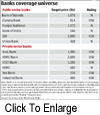Private banks are likely to deliver better results with stable margins and lower provisioning concerns. On a QoQ basis, we expect private banks to deliver 9% profit growth vs 4% for PSUs, while on a YoY basis, we see private banks leading with a 26% bottomline growth vs.16% for PSU banks.
 After seven lacklustre quarters, the sector finally saw a comeback of credit growth in Q3 despite a very tough liquidity environment, challenges in mobilising deposits and rapidly rising rates. While credit growth has been encouraging, deposit growth has lagged, forcing banks to raise deposit as well as lending rates frequently. Recent data suggests that most deposit hikes have been passed on by banks, suggesting that banks may preserve margin stability in Q3. However, PSU banks with longer duration deposits and shorter duration loans are likely to see an immediate margin benefit upfront, followed by a decline, led by deposit repricing catching up.
After seven lacklustre quarters, the sector finally saw a comeback of credit growth in Q3 despite a very tough liquidity environment, challenges in mobilising deposits and rapidly rising rates. While credit growth has been encouraging, deposit growth has lagged, forcing banks to raise deposit as well as lending rates frequently. Recent data suggests that most deposit hikes have been passed on by banks, suggesting that banks may preserve margin stability in Q3. However, PSU banks with longer duration deposits and shorter duration loans are likely to see an immediate margin benefit upfront, followed by a decline, led by deposit repricing catching up.
Provisions will be another important factor in upcoming Q3 earnings season? more so for PSU banks. While PSUs have recognised most of the one-off provisions in the previous quarter, slippages from restructured books may continue, though at a slower pace. Also, PSUs are likely to decide on the incremental pension liability that would impact economic value even though the hit to earnings maybe ameliorated by amortising it over the next




few years.
Most PSUs have been providing for this on an ad-hoc basis
and may have smaller incremental liabilities.
Given the higher earnings? visibility and fewer concerns for private banks coupled with valuations at their five-year average levels vs near all-time highs for PSU banks, we continue to prefer private banks over PSU banks in the near term. Prefer small private banks ?YES (Overweight, price Rs 291, target Rs 534) and IndusInd Bank (Overweight, price Rs 249, target Rs 400).
We value Indian banks using a weighted average combination of PE, PB (price to earnings, price to book) and EPM (economic profit model) methodologies. We assign a 75%, 15% and 10% weight each to the PE, PB and EPM components, respectively. The three-stage
EPM uses explicit forecasts until FY13e (other than HDFC, for which we have estimates till FY12e), followed by 10 years of semi-explicit forecasts.
?HSBC Global Research
















